Cilia organize ependymal planar polarity
- PMID: 20164345
- PMCID: PMC2873868
- DOI: 10.1523/JNEUROSCI.3744-09.2010
Cilia organize ependymal planar polarity
Abstract
Multiciliated epithelial cells, called ependymal cells, line the ventricles in the adult brain. Most ependymal cells are born prenatally and are derived from radial glia. Ependymal cells have a remarkable planar polarization that determines orientation of ciliary beating and propulsion of CSF. Disruption of ependymal ciliary beating, by injury or disease, results in aberrant CSF circulation and hydrocephalus, a common disorder of the CNS. Very little is known about the mechanisms guiding ependymal planar polarity and whether this organization is acquired during ependymal cell development or is already present in radial glia. Here we show that basal bodies in ependymal cells in the lateral ventricle walls of adult mice are polarized in two ways: (1) rotational; angle of individual basal bodies with respect to their long axis and (2) translational; the position of basal bodies on the apical surface of the cell. Conditional ablation of motile cilia disrupted rotational orientation, but translational polarity was largely preserved. In contrast, translational polarity was dramatically affected when radial glial primary cilia were ablated earlier in development. Remarkably, radial glia in the embryo have a translational polarity that predicts the orientation of mature ependymal cells. These results suggest that ependymal planar cell polarity is a multistep process initially organized by primary cilia in radial glia and then refined by motile cilia in ependymal cells.
Figures

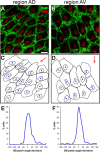
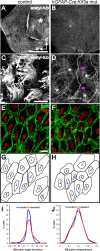
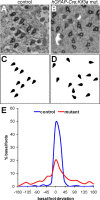
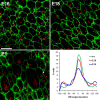
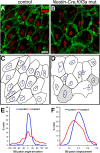

Similar articles
-
Mechanosensory Genes Pkd1 and Pkd2 Contribute to the Planar Polarization of Brain Ventricular Epithelium.J Neurosci. 2015 Aug 5;35(31):11153-68. doi: 10.1523/JNEUROSCI.0686-15.2015. J Neurosci. 2015. PMID: 26245976 Free PMC article.
-
Planar polarity of ependymal cilia.Differentiation. 2012 Feb;83(2):S86-90. doi: 10.1016/j.diff.2011.10.007. Epub 2011 Nov 17. Differentiation. 2012. PMID: 22101065 Review.
-
Myosin Id is required for planar cell polarity in ciliated tracheal and ependymal epithelial cells.Cytoskeleton (Hoboken). 2015 Oct;72(10):503-16. doi: 10.1002/cm.21259. Epub 2015 Oct 23. Cytoskeleton (Hoboken). 2015. PMID: 26446290 Free PMC article.
-
Lack of cadherins Celsr2 and Celsr3 impairs ependymal ciliogenesis, leading to fatal hydrocephalus.Nat Neurosci. 2010 Jun;13(6):700-7. doi: 10.1038/nn.2555. Epub 2010 May 16. Nat Neurosci. 2010. PMID: 20473291
-
Ependymal cell differentiation, from monociliated to multiciliated cells.Methods Cell Biol. 2015;127:19-35. doi: 10.1016/bs.mcb.2015.01.004. Epub 2015 Mar 7. Methods Cell Biol. 2015. PMID: 25837384 Review.
Cited by
-
Extracellular vesicles derived from the choroid plexus trigger the differentiation of neural stem cells.J Extracell Vesicles. 2022 Nov;11(11):e12276. doi: 10.1002/jev2.12276. J Extracell Vesicles. 2022. PMID: 36325603 Free PMC article.
-
The mouse radial spoke protein 3 is a nucleocytoplasmic shuttling protein that promotes neurogenesis.Histochem Cell Biol. 2015 Oct;144(4):309-19. doi: 10.1007/s00418-015-1338-y. Epub 2015 Jun 17. Histochem Cell Biol. 2015. PMID: 26082196
-
Genetic deletion of afadin causes hydrocephalus by destruction of adherens junctions in radial glial and ependymal cells in the midbrain.PLoS One. 2013 Nov 13;8(11):e80356. doi: 10.1371/journal.pone.0080356. eCollection 2013. PLoS One. 2013. PMID: 24236178 Free PMC article.
-
Secondary Brain Injury Following Neonatal Intraventricular Hemorrhage: The Role of the Ciliated Ependyma.Front Pediatr. 2022 Jun 30;10:887606. doi: 10.3389/fped.2022.887606. eCollection 2022. Front Pediatr. 2022. PMID: 35844746 Free PMC article. Review.
-
Schizophrenia-related microdeletion causes defective ciliary motility and brain ventricle enlargement via microRNA-dependent mechanisms in mice.Nat Commun. 2020 Feb 14;11(1):912. doi: 10.1038/s41467-020-14628-y. Nat Commun. 2020. PMID: 32060266 Free PMC article.
References
-
- al-Shroof M, Karnik AM, Karnik AA, Longshore J, Sliman NA, Khan FA. Ciliary dyskinesia associated with hydrocephalus and mental retardation in a Jordanian family. Mayo Clin Proc. 2001;76:1219–1224. - PubMed
-
- Banizs B, Pike MM, Millican CL, Ferguson WB, Komlosi P, Sheetz J, Bell PD, Schwiebert EM, Yoder BK. Dysfunctional cilia lead to altered ependyma and choroid plexus function, and result in the formation of hydrocephalus. Development. 2005;132:5329–5339. - PubMed
-
- Boisvieux-Ulrich E, Laine MC, Sandoz D. The orientation of ciliary basal bodies in quail oviduct is related to the ciliary beating cycle commencement. Biol Cell. 1985;55:147–150. - PubMed
-
- Bruni JE. Ependymal development, proliferation, and functions: a review. Microsc Res Tech. 1998;41:2–13. - PubMed
Publication types
MeSH terms
Substances
Grants and funding
LinkOut - more resources
Full Text Sources
Other Literature Sources
Molecular Biology Databases
